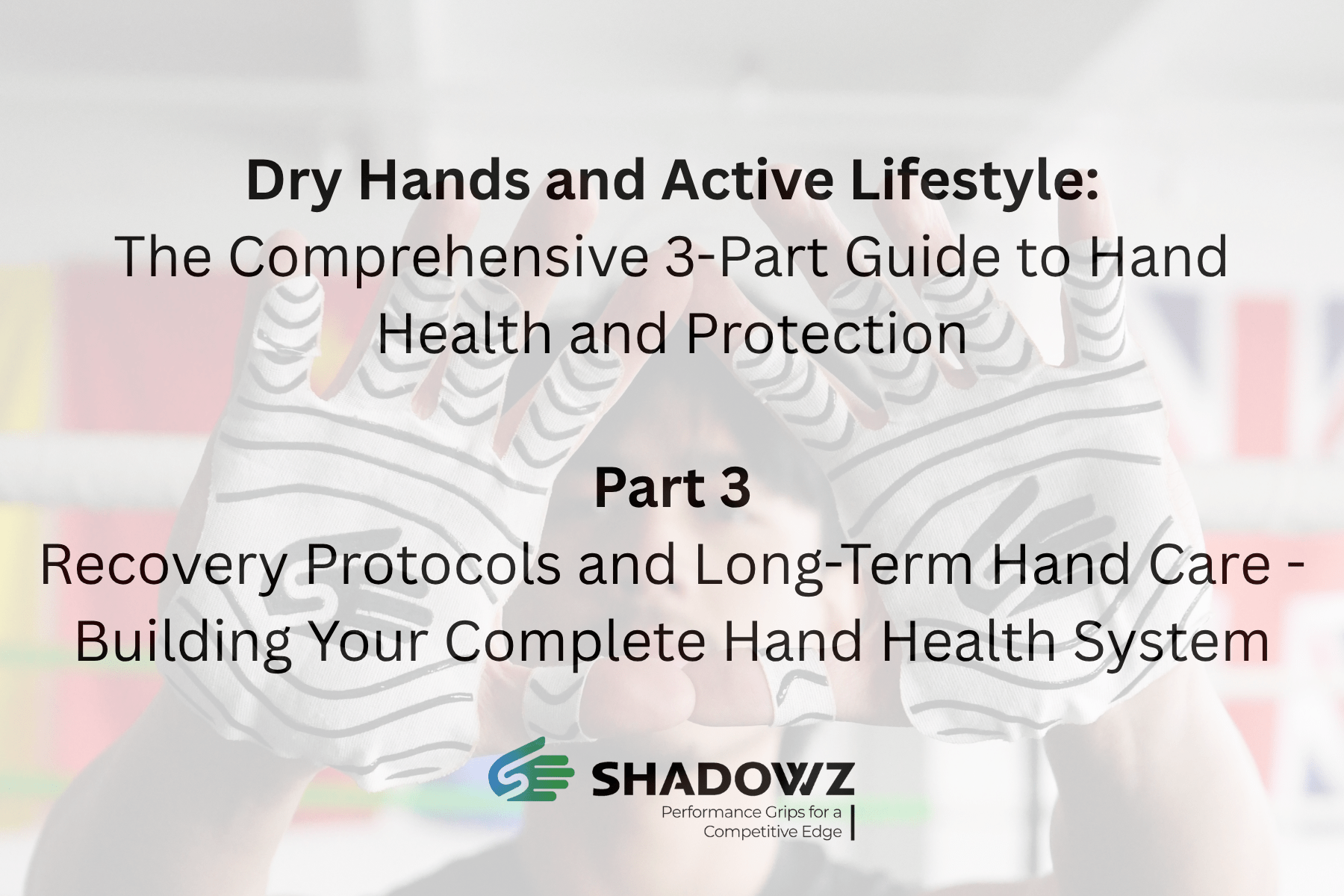This is Part 3 of a 3-part series on protecting your hands during active pursuits. Part 1 covered the science behind hand damage, and Part 2 detailed prevention strategies and protection tools. This final installment focuses on recovery and long-term maintenance.
Even with perfect prevention and protection, active hands need dedicated recovery protocols. The difference between athletes who maintain healthy hands throughout their careers and those who struggle with chronic problems often comes down to what happens after the workout ends.
Recovery isn't just about healing damage—it's about optimizing your hands' ability to adapt to training stress and maintain peak performance over time.
Post-Activity Recovery: The Critical First Hour
The first hour after training represents a crucial window for hand recovery. During this time, your skin is most receptive to treatment, and proper intervention can significantly reduce long-term damage accumulation.
Immediate Care Protocol (Within 30 Minutes)
Step 1: Gentle Cleansing
The Process: Wash hands with lukewarm water and mild soap. Avoid hot water, which further strips natural oils. Pat dry rather than rubbing.
Why This Matters: Removing chalk, sweat, and bacteria prevents irritation and infection while you sleep. However, aggressive washing can worsen the drying effect of exercise.
Pro Technique: Use a pH-balanced cleanser if possible. Soap-free cleansers are even better for severely compromised skin.
Step 2: Damage Assessment
What to Look For:
- Any cuts, tears, or areas of excessive redness
- Hot spots that feel tender or appear inflamed
- Areas where calluses are building unevenly
- Signs of infection (increasing warmth, streaking, unusual pain)
Documentation Tip: Take weekly photos of your hands to track changes over time. Problems are easier to address when caught early.
Step 3: Immediate Hydration
The Technique: While skin is still slightly damp, apply a heavy moisturizer or healing cream. This traps residual moisture and begins the repair process.
Product Selection: Look for ingredients like:
- Hyaluronic acid (holds 1000x its weight in water)
- Glycerin (draws moisture from the environment)
- Shea butter (provides long-lasting barrier protection)
- Allantoin (promotes healing and reduces inflammation)
Advanced Recovery Techniques
Overnight Intensive Treatment
Overnight Treatment: For severely dry or damaged hands, apply a thick layer of healing ointment containing ingredients like urea, lactic acid, or glycolic acid. Cover with cotton gloves to prevent transfer and enhance absorption.
The Science: Occlusion (covering treated skin) increases product penetration by up to 400%. The added warmth and moisture create an ideal healing environment.
Frequency: Use 2-3 times per week for maintenance, nightly for damaged hands until healing occurs.
Weekly Intensive Care
Exfoliation Protocol: Use a gentle exfoliating scrub once weekly to remove dead skin buildup. Follow with intensive moisturization.
DIY Option: Mix equal parts sugar and olive oil with a drop of honey. Gently massage for 30 seconds, then rinse and moisturize.
Professional Option: Consider monthly professional hand treatments if hand health is critical to your sport or profession.
Callus Management: The Balancing Act
Calluses aren't inherently bad—they're your body's adaptation to repeated stress. The goal is maintaining optimal thickness for protection without allowing them to become problematic.
The Goldilocks Principle of Calluses
Too Little: Inadequate protection leads to blisters and tears Too Much: Thick, rigid calluses create pressure points and are prone to ripping off Just Right: A thin, flexible layer of slightly thickened skin provides protection without compromising function
Weekly Callus Maintenance
Assessment (Every Sunday)
- Feel for raised areas or rough patches
- Check for asymmetry between hands
- Note any tender or inflamed areas
Filing Technique
Tools: Use a pumice stone or callus file, never a razor or blade Timing: File when skin is soft (after shower or bath) Technique: Gentle, consistent pressure in one direction Goal: Reduce height by 20-30%, never file to level with surrounding skin
Post-Filing Care
Always moisturize heavily after filing to prevent cracking and promote healthy skin regeneration.
Long-Term Hand Health Strategies
The 80/20 Rule of Hand Care
Focus on the 20% of activities that provide 80% of the benefit:
Daily Essentials (The 20%):
- Post-workout moisturizing
- Proper hand washing technique
- Nail maintenance
- Basic callus monitoring
Weekly Additions:
- Intensive moisturizing treatment
- Callus filing as needed
- Hand and wrist mobility work
- Equipment cleaning and maintenance
Monthly Reviews:
- Comprehensive hand assessment
- Equipment replacement as needed
- Technique review and adjustment
- Professional consultation if needed
Seasonal Adjustments
Your hand care needs change with the seasons and your training cycles.
Winter Modifications
- Increase moisturizing frequency
- Use heavier, more occlusive products
- Pay attention to indoor heating effects
- Consider humidifiers in sleeping areas
Summer Adaptations
- Focus on sweat management
- Increase hand washing frequency
- Use lighter, quick-absorbing moisturizers during the day
- Maintain heavy treatment for nighttime
Competition Season
- Prioritize prevention over treatment
- Increase protective measures during training
- Have emergency repair protocols ready
- Consider prophylactic taping for vulnerable areas
Troubleshooting Common Problems
Problem: Persistent Dry Skin Despite Moisturizing
Possible Causes: Product not appropriate for severity, underlying skin condition, environmental factors Solutions:
- Upgrade to prescription-strength moisturizers
- Add humidifier to bedroom
- Consult dermatologist for possible eczema or other conditions
- Review cleaning products and hand-washing frequency
Problem: Recurring Tears in Same Location
Possible Causes: Technique issues, inadequate protection, poor callus management Solutions:
- Video analysis of grip technique
- Upgrade protection for that specific area
- Pre-emptive taping of vulnerable spots
- Consider equipment modifications (grip thickness, texture)
Problem: Calluses Keep Getting Thicker Despite Filing
Possible Causes: Over-filing leading to protective response, inadequate protection during activity, poor technique Solutions:
- Reduce filing frequency and intensity
- Increase protection during training
- Professional assessment of filing technique
- Consider technique modifications to reduce stress
Problem: Hands Look "Too Rough" for Professional/Social Settings
Solutions:
- Increase prevention rather than trying to "fix" damage
- Regular professional manicures focused on health
- Shadowz Grips or similar advanced protection
- Strategic timing of intensive activities around important events
When to Seek Professional Help
Dermatologist Consultation
Seek help for:
- Persistent cracks that won't heal
- Signs of infection (increased warmth, red streaking, pus)
- Sudden changes in skin texture or appearance
- Severe dryness that doesn't respond to treatment
Sports Medicine/Physical Therapy
Consider for:
- Technique-related hand problems
- Chronic pain associated with gripping
- Recurring injuries in the same location
- Performance limitations due to hand issues
Professional Hand Care Services
Benefits of regular professional care:
- Expert callus management
- Access to professional-grade treatments
- Objective assessment of hand health
- Preventive care recommendations
Building Your Personal Hand Care System
Assessment: Where Are You Now?
Rate yourself (1-5 scale) in each area:
- Current hand condition
- Consistency of preventive care
- Quality of protective equipment
- Recovery protocol adherence
- Long-term planning
Goal Setting: Where Do You Want to Be?
Consider both performance and aesthetic goals:
- Functional requirements for your sport/activities
- Professional appearance needs
- Personal comfort preferences
- Long-term health priorities
System Design: Your Custom Protocol
Level 1: Basics (Everyone)
- Daily post-activity moisturizing
- Weekly callus check and maintenance
- Proper protective equipment for primary activity
- Basic technique awareness
Level 2: Intermediate (Serious Athletes)
- Activity-specific protection protocols
- Advanced moisturizing treatments
- Regular technique assessment
- Seasonal protocol adjustments
Level 3: Advanced (Elite/Professional)
- Daily detailed hand assessment
- Professional support team involvement
- Cutting-edge protective equipment like Shadowz Grips
- Preventive maintenance scheduling
- Performance tracking and optimization
The Long-Term Perspective
Maintaining healthy hands throughout an active lifestyle isn't about avoiding all damage—it's about managing the balance between performance and preservation. The most successful athletes understand that consistent hand care prevents the dramatic injuries that can derail training for weeks.
Success Metrics
Track your progress with both objective and subjective measures:
Objective Measures:
- Days lost to hand injuries per year
- Grip strength maintenance over time
- Frequency of tears or significant damage
- Photos showing long-term skin health trends
Subjective Measures:
- Comfort during and after training
- Confidence in grip security
- Satisfaction with hand appearance
- Overall quality of life impact
The Compound Effect
Small, consistent actions in hand care create compound benefits over time:
- Better daily training quality
- Reduced risk of season-ending injuries
- Maintained ability to pursue activities long-term
- Confidence in both athletic and professional settings
Products like Shadowz Grips represent the evolution of understanding that hand health and performance aren't opposing goals—they're complementary aspects of athletic excellence.
Your Action Plan
Week 1: Foundation
- Implement basic post-workout moisturizing
- Assess current hand condition with photos
- Upgrade your primary protective equipment if needed
Week 2-4: Routine Development
- Add pre-activity preparation protocols
- Begin weekly callus maintenance
- Establish damage assessment habits
Month 2: Optimization
- Fine-tune product selection based on results
- Add advanced treatments as needed
- Consider upgrading to specialized protection like Shadowz Grips
Month 3+: Maintenance and Growth
- Develop seasonal protocols
- Integrate professional support as appropriate
- Focus on long-term sustainability
Conclusion: Your Hands, Your Performance, Your Choice
The days of accepting torn, damaged hands as the price of an active lifestyle are over. Through understanding the science of skin health, implementing proper prevention and recovery protocols, and using advanced protection solutions, it's entirely possible to maintain both peak performance and healthy hands.
Whether you're just starting your fitness journey or you're a seasoned athlete looking to optimize your approach, investing in proper hand care will pay dividends in comfort, performance, and long-term health. Your hands are the interface between your body and your goals—treating them with the care they deserve isn't vanity, it's performance optimization.
Remember: the best hand care system is one you'll actually use consistently. Start with the basics, incorporate advanced solutions like Shadowz Grips as your needs develop, and adjust based on your activities and results.
Your future self—and your training partners—will thank you for making hand health a priority today.
This concludes our 3-part series on hand protection for active lifestyles. For more information on advanced hand protection solutions, visit ShadowzGrips.com.





